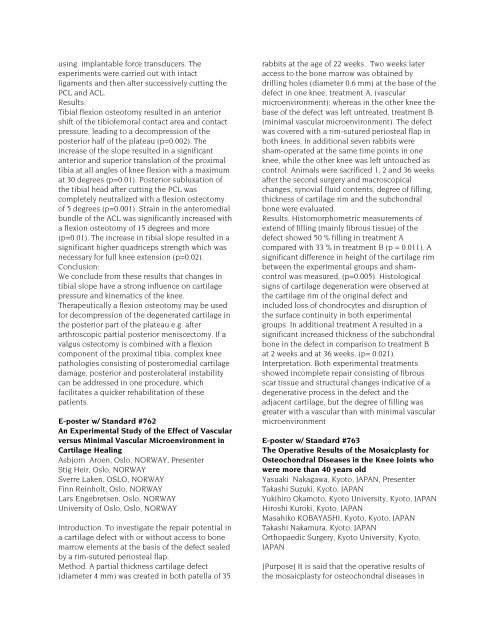POSTER ABSTRACTS - ISAKOS
POSTER ABSTRACTS - ISAKOS
POSTER ABSTRACTS - ISAKOS
You also want an ePaper? Increase the reach of your titles
YUMPU automatically turns print PDFs into web optimized ePapers that Google loves.
using implantable force transducers. The<br />
experiments were carried out with intact<br />
ligaments and then after successively cutting the<br />
PCL and ACL.<br />
Results:<br />
Tibial flexion osteotomy resulted in an anterior<br />
shift of the tibiofemoral contact area and contact<br />
pressure, leading to a decompression of the<br />
posterior half of the plateau (p=0.002). The<br />
increase of the slope resulted in a significant<br />
anterior and superior translation of the proximal<br />
tibia at all angles of knee flexion with a maximum<br />
at 30 degrees (p=0.01). Posterior subluxation of<br />
the tibial head after cutting the PCL was<br />
completely neutralized with a flexion osteotomy<br />
of 5 degrees (p=0.001). Strain in the anteromedial<br />
bundle of the ACL was significantly increased with<br />
a flexion osteotomy of 15 degrees and more<br />
(p=0.01). The increase in tibial slope resulted in a<br />
significant higher quadriceps strength which was<br />
necessary for full knee extension (p=0.02).<br />
Conclusion:<br />
We conclude from these results that changes in<br />
tibial slope have a strong influence on cartilage<br />
pressure and kinematics of the knee.<br />
Therapeutically a flexion osteotomy may be used<br />
for decompression of the degenerated cartilage in<br />
the posterior part of the plateau e.g. after<br />
arthroscopic partial posterior meniscectomy. If a<br />
valgus osteotomy is combined with a flexion<br />
component of the proximal tibia, complex knee<br />
pathologies consisting of posteromedial cartilage<br />
damage, posterior and posterolateral instability<br />
can be addressed in one procedure, which<br />
facilitates a quicker rehabilitation of these<br />
patients.<br />
E-poster w/ Standard #762<br />
An Experimental Study of the Effect of Vascular<br />
versus Minimal Vascular Microenvironment in<br />
Cartilage Healing<br />
Asbjorn Aroen, Oslo, NORWAY, Presenter<br />
Stig Heir, Oslo, NORWAY<br />
Sverre Laken, OSLO, NORWAY<br />
Finn Reinholt, Oslo, NORWAY<br />
Lars Engebretsen, Oslo, NORWAY<br />
University of Oslo, Oslo, NORWAY<br />
Introduction. To investigate the repair potential in<br />
a cartilage defect with or without access to bone<br />
marrow elements at the basis of the defect sealed<br />
by a rim-sutured periosteal flap.<br />
Method. A partial thickness cartilage defect<br />
(diameter 4 mm) was created in both patella of 35<br />
rabbits at the age of 22 weeks. Two weeks later<br />
access to the bone marrow was obtained by<br />
drilling holes (diameter 0.6 mm) at the base of the<br />
defect in one knee, treatment A, (vascular<br />
microenvironment); whereas in the other knee the<br />
base of the defect was left untreated, treatment B<br />
(minimal vascular microenvironment). The defect<br />
was covered with a rim-sutured periosteal flap in<br />
both knees. In additional seven rabbits were<br />
sham-operated at the same time points in one<br />
knee, while the other knee was left untouched as<br />
control. Animals were sacrificed 1, 2 and 36 weeks<br />
after the second surgery and macroscopical<br />
changes, synovial fluid contents, degree of filling,<br />
thickness of cartilage rim and the subchondral<br />
bone were evaluated.<br />
Results. Histomorphometric measurements of<br />
extend of filling (mainly fibrous tissue) of the<br />
defect showed 50 % filling in treatment A<br />
compared with 33 % in treatment B (p = 0.011). A<br />
significant difference in height of the cartilage rim<br />
between the experimental groups and shamcontrol<br />
was measured, (p=0.005). Histological<br />
signs of cartilage degeneration were observed at<br />
the cartilage rim of the original defect and<br />
included loss of chondrocytes and disruption of<br />
the surface continuity in both experimental<br />
groups. In additional treatment A resulted in a<br />
significant increased thickness of the subchondral<br />
bone in the defect in comparison to treatment B<br />
at 2 weeks and at 36 weeks, (p= 0.021).<br />
Interpretation. Both experimental treatments<br />
showed incomplete repair consisting of fibrous<br />
scar tissue and structural changes indicative of a<br />
degenerative process in the defect and the<br />
adjacent cartilage, but the degree of filling was<br />
greater with a vascular than with minimal vascular<br />
microenvironment<br />
E-poster w/ Standard #763<br />
The Operative Results of the Mosaicplasty for<br />
Osteochondral Diseases in the Knee Joints who<br />
were more than 40 years old<br />
Yasuaki Nakagawa, Kyoto, JAPAN, Presenter<br />
Takashi Suzuki, Kyoto, JAPAN<br />
Yukihiro Okamoto, Kyoto University, Kyoto, JAPAN<br />
Hiroshi Kuroki, Kyoto, JAPAN<br />
Masahiko KOBAYASHI, Kyoto, Kyoto, JAPAN<br />
Takashi Nakamura, Kyoto, JAPAN<br />
Orthopaedic Surgery, Kyoto University, Kyoto,<br />
JAPAN<br />
[Purpose] It is said that the operative results of<br />
the mosaicplasty for osteochondral diseases in
















